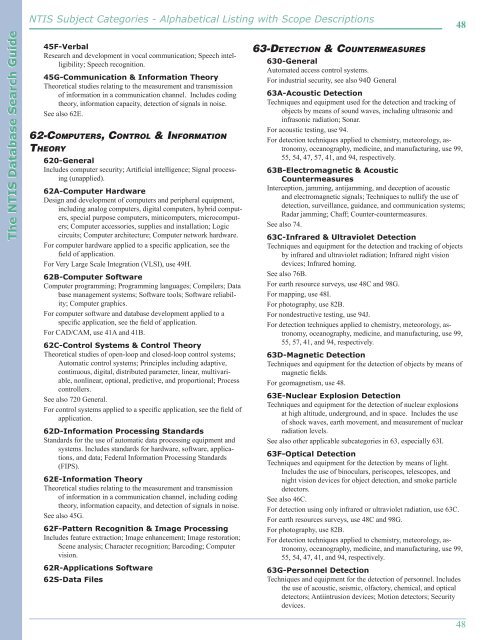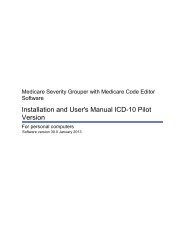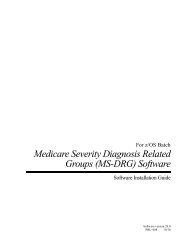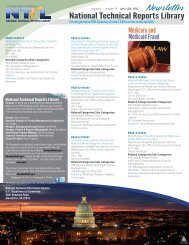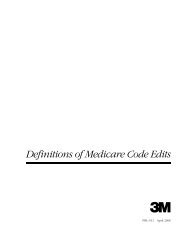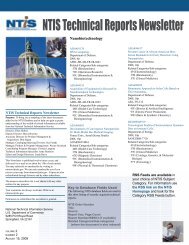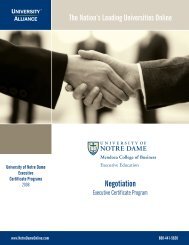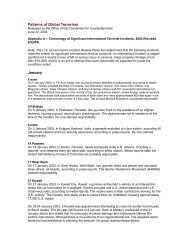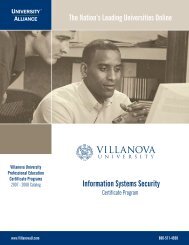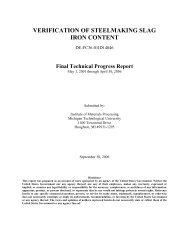DATABASE GUIDE - National Technical Information Service
DATABASE GUIDE - National Technical Information Service
DATABASE GUIDE - National Technical Information Service
Create successful ePaper yourself
Turn your PDF publications into a flip-book with our unique Google optimized e-Paper software.
NTIS Subject Categories - Alphabetical Listing with Scope Descriptions4845F‐VerbalResearch and development in vocal communication; Speech intelligibility;Speech recognition.45G‐Communication & <strong>Information</strong> TheoryTheoretical studies relating to the measurement and transmissionof information in a communication channel. Includes codingtheory, information capacity, detection of signals in noise.See also 62E.62‐Computers, Control & <strong>Information</strong>Theory620‐GeneralIncludes computer security; Artificial intelligence; Signal processing(unapplied).62A‐Computer HardwareDesign and development of computers and peripheral equipment,including analog computers, digital computers, hybrid computers,special purpose computers, minicomputers, microcomputers;Computer accessories, supplies and installation; Logiccircuits; Computer architecture; Computer network hardware.For computer hardware applied to a specific application, see thefield of application.For Very Large Scale Integration (VLSI), use 49H.62B‐Computer SoftwareComputer programming; Programming languages; Compilers; Database management systems; Software tools; Software reliability;Computer graphics.For computer software and database development applied to aspecific application, see the field of application.For CAD/CAM, use 41A and 41B.62C‐Control Systems & Control TheoryTheoretical studies of open‐loop and closed‐loop control systems;Automatic control systems; Principles including adaptive,continuous, digital, distributed parameter, linear, multivariable,nonlinear, optional, predictive, and proportional; Processcontrollers.See also 720 General.For control systems applied to a specific application, see the field ofapplication.62D‐<strong>Information</strong> Processing StandardsStandards for the use of automatic data processing equipment andsystems. Includes standards for hardware, software, applications,and data; Federal <strong>Information</strong> Processing Standards(FIPS).62E‐<strong>Information</strong> TheoryTheoretical studies relating to the measurement and transmissionof information in a communication channel, including codingtheory, information capacity, and detection of signals in noise.See also 45G.62F‐Pattern Recognition & Image ProcessingIncludes feature extraction; Image enhancement; Image restoration;Scene analysis; Character recognition; Barcoding; Computervision.62R‐Applications Software62S‐Data Files63‐Detection & Countermeasures630‐GeneralAutomated access control systems.For industrial security, see also 940 General63A‐Acoustic DetectionTechniques and equipment used for the detection and tracking ofobjects by means of sound waves, including ultrasonic andinfrasonic radiation; Sonar.For acoustic testing, use 94.For detection techniques applied to chemistry, meteorology, astronomy,oceanography, medicine, and manufacturing, use 99,55, 54, 47, 57, 41, and 94, respectively.63B‐Electromagnetic & AcousticCountermeasuresInterception, jamming, antijamming, and deception of acousticand electromagnetic signals; Techniques to nullify the use ofdetection, surveillance, guidance, and communication systems;Radar jamming; Chaff; Counter‐countermeasures.See also 74.63C‐Infrared & Ultraviolet DetectionTechniques and equipment for the detection and tracking of objectsby infrared and ultraviolet radiation; Infrared night visiondevices; Infrared homing.See also 76B.For earth resource surveys, use 48C and 98G.For mapping, use 48I.For photography, use 82B.For nondestructive testing, use 94J.For detection techniques applied to chemistry, meteorology, astronomy,oceanography, medicine, and manufacturing, use 99,55, 57, 41, and 94, respectively.63D‐Magnetic DetectionTechniques and equipment for the detection of objects by means ofmagnetic fields.For geomagnetism, use 48.63E‐Nuclear Explosion DetectionTechniques and equipment for the detection of nuclear explosionsat high altitude, underground, and in space. Includes the useof shock waves, earth movement, and measurement of nuclearradiation levels.See also other applicable subcategories in 63, especially 63I.63F‐Optical DetectionTechniques and equipment for the detection by means of light.Includes the use of binoculars, periscopes, telescopes, andnight vision devices for object detection, and smoke particledetectors.See also 46C.For detection using only infrared or ultraviolet radiation, use 63C.For earth resources surveys, use 48C and 98G.For photography, use 82B.For detection techniques applied to chemistry, meteorology, astronomy,oceanography, medicine, and manufacturing, use 99,55, 54, 47, 41, and 94, respectively.63G‐Personnel DetectionTechniques and equipment for the detection of personnel. Includesthe use of acoustic, seismic, olfactory, chemical, and opticaldetectors; Antiintrusion devices; Motion detectors; Securitydevices.48


